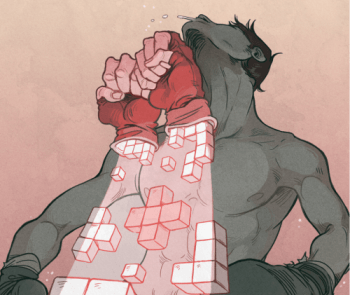Jun 27 2016
In the struggle against cancer treatment resistance, nanotechnology, math, and biology are becoming strange, yet effective. An innovative approach towards cancer treatment that pits a deadly mixture of drugs together into a sole nanoparticle, has been engineered by the University of Waterloo and Harvard Medical School scientists.
 (Credit: Gabriel Picolo "2-in-1 punch")
(Credit: Gabriel Picolo "2-in-1 punch")
Their study has been published online in ACS Nano, a leading nanotechnology journal, on June 3, 2016. The paper describes a novel method that helps to reduce the size of tumors and prevent resistance in destructive cancers by stimulating two drugs within the same cell simultaneously.
Many patients die every year due to recurrent cancers that have become resistant to therapy, leading to one of the biggest challenges in cancer treatment that is yet to be solved. Bioengineers and biologists at Harvard Medical School made a study on the network of signals and molecular pathways that permit the cells to become resistant during the course of therapy, by monitoring the individual cancer cells undergoing chemotherapy.
A group of applied mathematicians headed by Professor Mohammad Kohandel from the University of Waterloo, created a mathematical model using this information, which included algorithms that describe the cancer cells’ phenotypic cell state transitions in real-time while being attacked by an anticancer agent. The researchers were able to describe the precise molecular behavior and signal pathway using the mathematical model. This enabled cancer cells to endure treatment over a period of time.
The researchers found that the PI3K/AKT kinase, which is frequently over-stimulated in cancers, permits cells to go through a resistance program when they are pressured with Taxanes, a cytotoxic chemotherapy. Taxanes are traditionally used for the treatment of aggressive breast cancers. This insight into the cell’s life shows that susceptibilities to PI3K/AKT kinase inhibitors exist, and could be targeted if applied in the correct sequence with different combinations of various other drugs.
Earlier drug resistance theories have been based on the theory that only few, “privileged” cells can sustain therapy. The mathematical models prove that any cell can build a resistance program under the appropriate conditions and signaling events.
Only recently have we begun to appreciate how important mathematics and physics are to understanding the biology and evolution of cancer. In fact, there is now increasing synergy between these disciplines, and we are beginning to appreciate how critical this information can be to create the right recipes to treat cancer.
Professor Mohammad Kohandel, University of Waterloo
Even though earlier research investigated the application of drug combinations to treat cancer, the one-two punch approach is not always found to be successful. Professor Aaron Goldman, a faculty member in Engineering in Medicine at Brigham and Women’s Hospital, headed a new study in which the researchers realized a key limitation of the combination therapy approach. They found that both the drugs have to be active in the same cell, a criteria which current delivery methods cannot assure.
“We were inspired by the mathematical understanding that a cancer cell rewires the mechanisms of resistance in a very specific order and time-sensitive manner,” explained Professor Goldman. “By developing a 2-in-1 nanomedicine, we could ensure the cell that was acquiring this new resistance saw the lethal drug combination, shutting down the survival program and eliminating the evidence of resistance. This approach could redefine how clinicians deliver combinations of drugs in the clinic.”
The bioengineers built a single nanoparticle, by drawing inspiration from computer models that utilize a technique referred to as supramolecular chemistry. Nanotechnology thus helps researchers to formulate cholesterol-tethered drugs with “tetris-like” building blocks that assemble by themselves, adding numerous drugs into stable, single nano-vehicles that target tumors via the leaky vasculature. This 2-in-1 strategy brings together the correct recipe to kill surviving cancer cells by ensuring that resistance to therapy does not develop.
The researchers confirmed the mathematical model predictions that both the drugs must be deterministically transported to the same cell, using mouse models of destructive breast cancer.